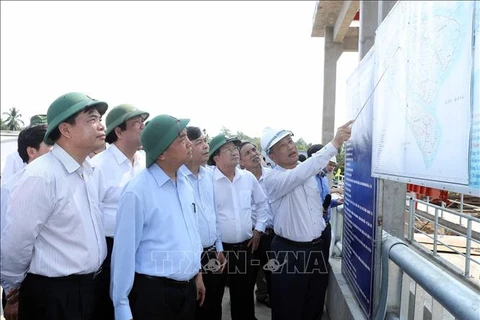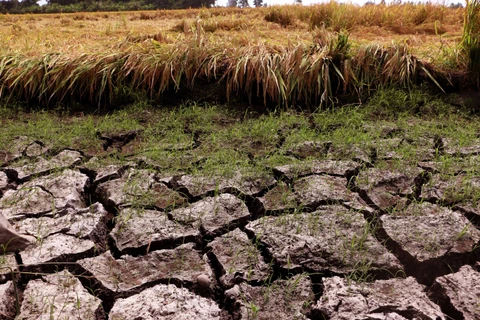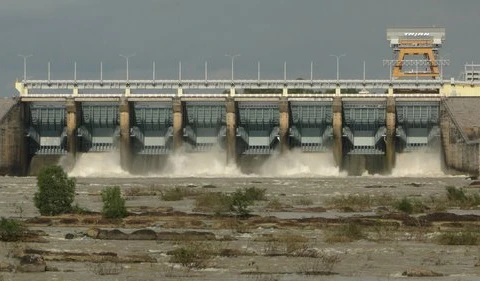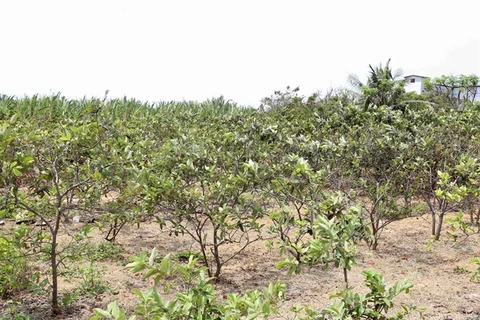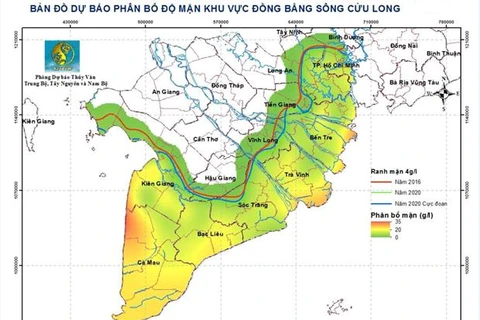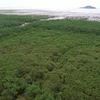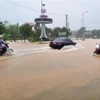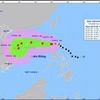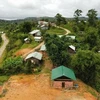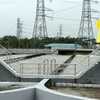Hanoi (VNA) – From now to May, water flows to be recorded at upstream monitoring stations on the Mekong River are likely to be 5 – 20 percent less than those in 2016, when historic drought and saline encroachment were reported. Saltwater intrusion on the Mekong River will abate gradually but still be at high levels. In some extreme scenarios, it may even prolong and get more serious.
Salinity to remain high
According to the National Centre for Hydro-Meteorological Forecasting, there have been almost no rains in the Mekong Delta region over the past days. Only certain areas in Rach Gia city of Kien Giang province recorded rainfall of 7mm on March 21 and 23.
Heat waves still occur, mostly in the southeastern region, with the highest temperatures of 35 – 37 degrees Celsius. On March 23, the hot weather was reported in some places of the southwestern region (Mekong Delta) like Cao Lanh city of Dong Thap province and Chau Doc city of An Giang province.
Water levels on the mainstream Mekong River have changed slowly and been 0.1 – 0.5 metre lower than the same period of 2016. As a result, water levels on the Tien and Hau rivers, two main distributaries of the Mekong River in Vietnam, have also followed the same trend, with the highest measured at the Tan Chau station 0.95 metre and at the Chau Doc station 1.11 metres on March 21 – equivalent to the levels in the same period of 2016.
The meteorological agency predicted that the southern region will continue to see little rainfall and strong heat in the next few days. In particular, southeastern localities will continue to experience widespread heat with the highest temperatures of 35 – 37 degrees Celsius while only little rainfall will be likely in several areas in the southwestern region.
[Mekong Delta adapts to drought, saltwater intrusion]
Meanwhile, water levels on the upper Mekong River are projected to change slowly and be 0.1 – 0.5 metre lower than the same period of 2016. The highest levels measured at the Tan Chau station will be 1 metre and at the Chau Doc station 1.15 metres – comparable to data recorded in the same period of 2016.
Water with the salinity level of one gramme per litre may encroach 110 – 130km deep into the Vam Co Dong and Vam Co Tay rivers, 65 – 75km into the Cua Tieu and Cua Dai rivers, 80 – 85km into the Ham Luong River, 60 – 75km into the Co Chien River, 55 – 65km into the Hau River, and 58 – 63km into the Cai Lon River.
The salinity level of four grammes per litre is forecast to evade 86 – 110km deep into the Vam Co Dong and Vam Co Tay rivers, 52 – 60km into the Cua Tieu and Cua Dai rivers, 73 – 78km into the Ham Luong River, 45 – 55km into the Co Chien and Hau rivers, and 43 – 52km into the Cai Lon River.
The National Centre for Hydro-Meteorological Forecasting said from April 1 to 5, saltwater intrusion in the Mekong Delta will ease slowly on the first couple of days and then increase again.
Therefore, from March 26 to April 5, localities in this region should store as much fresh water as possible when tides are low. Besides, local farmers should check salinity levels carefully before watering their orchards so as to avoid losses.
From now to May, water flows measured at upstream monitoring stations will be 5 – 20 percent less than in 2016.
Saltwater intrusion in river mouths will ease gradually but remain high through the end of March. Notably, it will stay severe on the Vam Co River in Long An province, the Cai Lon River in Kien Giang province, and Ca Mau Peninsula until late April and early May before abating gradually.
In extreme scenarios, if the rain shortage prolongs, the use of water on distributaries increases and hydropower dams boost water storage, drought and saline encroachment will linger and become more serious, the meteorological agency noted.
Early warning for coming period
In the high-emission scenario, by the end of the 21st century, the sea level will rise by about 57 – 73cm along the entire coastline of Vietnam. Particularly, it will rise by up to 105cm in the coastal areas from Ca Mau to Kien Giang provinces. As a result, a majority of the Mekong Delta – the largest rice production hub of Vietnam – will disappear due to flooding and saltwater invasion.
It is a fact that over the last 25 years, from a stable land, the Mekong Delta has experienced a shortage of sediment, increased tidal amplitude, and strong saline encroachment, leading to severe freshwater scarcity, subsidence and land erosion.
Dr Philip Minderhoud, head of a study on impact of groundwater extraction and saltwater intrusion amid subsidence in the Mekong Delta – part of a cooperation programme between Vietnam and the Netherlands, attributed the local sediment shortage to the building of hydropower dams in the upper Mekong River and large-scale sand mining in lower areas.
This region is now only 0.8 metre higher than the sea level, nearly 2 metres lower than the previous estimates, he said, warning that if sand mining and groundwater extraction remain uncontrolled like at present, the largest rice production hub of Vietnam may face the risk of sinking below the sea level by 2100.
Although many people held that those statistics are merely for consultation, and regardless of how climate change is, consequences will not be so serious, and that there remains much time, from now to the end of this century, for the country to take timely measures to minimise damage.
However, right now, the Mekong Delta is being battered by drought and saltwater intrusion. Groundwater resources in this region have exhausted and been polluted, exposing local residents to numerous difficulties. In Hau Giang, Soc Trang and Ca Mau provinces alone, more than 291,000 wells have been dug to extract groundwater for daily use, agriculture and aquaculture.
The exhaustion of water resources in the country’s largest rice production hub has substantially affected the realisation of sustainable development goals. Rice and fruit farmers who account for the majority of the local population are facing risks of job and income loss.
Deputy Minister of Natural Resources and Environment Le Cong Thanh said as drought has begun spreading to the central and Central Highlands regions, it is necessary to keep a close watch on the situation and forecast which regions may encounter serious water scarcity in the next three months so as to issue warnings, thus helping people and authorities there prepare response measures.
He also asked for water shortage predictions for 2021 and 2022 to give early warnings to ministries, sectors and localities./.



